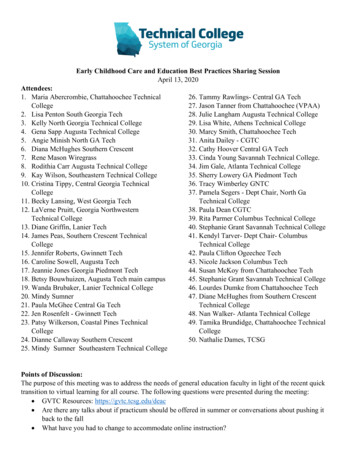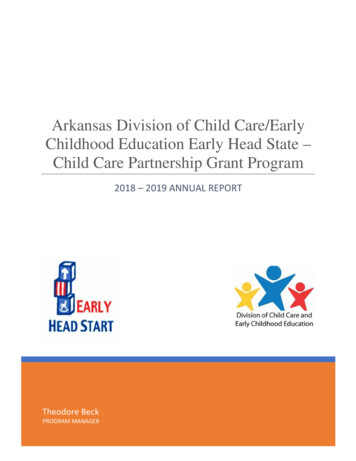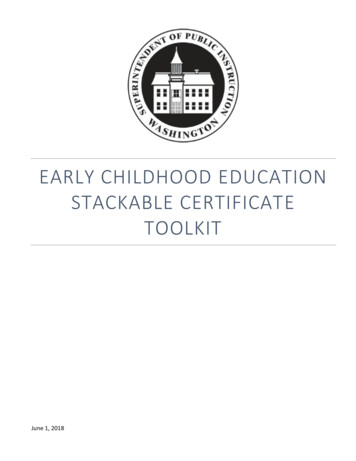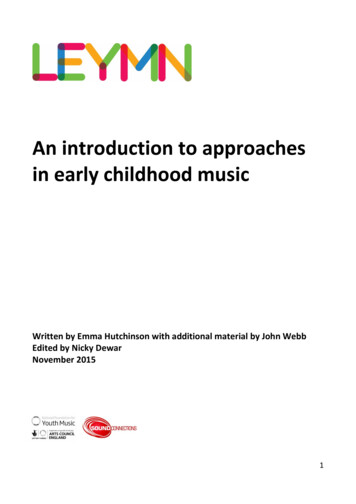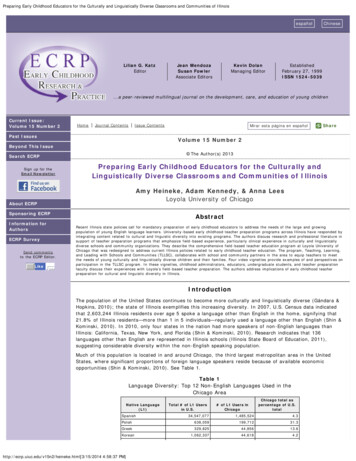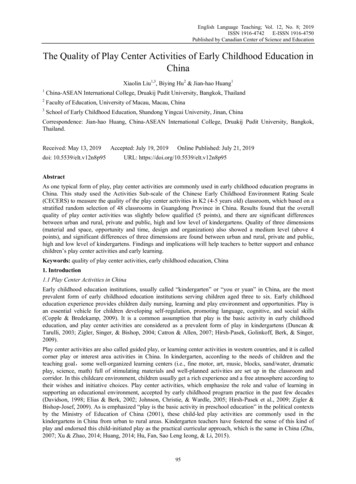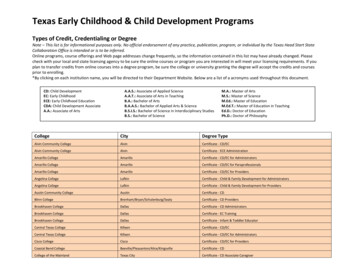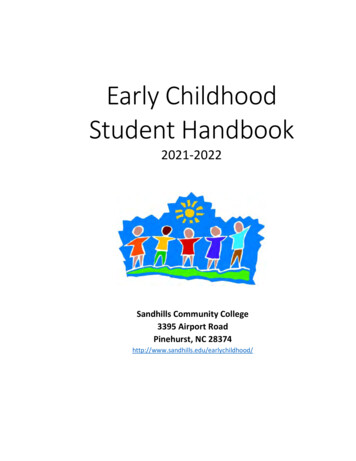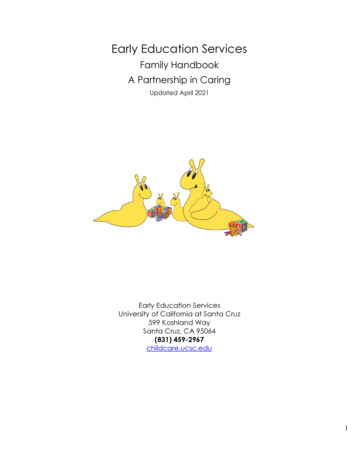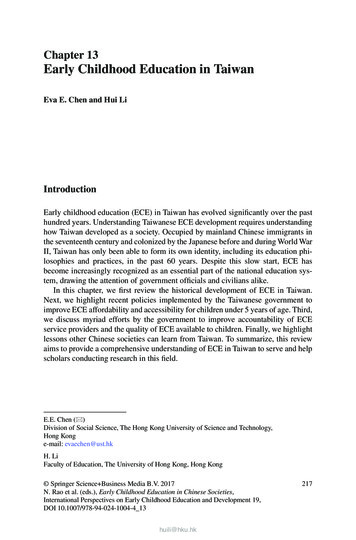
Transcription
Chapter 13Early Childhood Education in TaiwanEva E. Chen and Hui Li IntroductionEarly childhood education (ECE) in Taiwan has evolved significantly over the pasthundred years. Understanding Taiwanese ECE development requires understandinghow Taiwan developed as a society. Occupied by mainland Chinese immigrants inthe seventeenth century and colonized by the Japanese before and during World WarII, Taiwan has only been able to form its own identity, including its education philosophies and practices, in the past 60 years. Despite this slow start, ECE hasbecome increasingly recognized as an essential part of the national education system, drawing the attention of government officials and civilians alike.In this chapter, we first review the historical development of ECE in Taiwan.Next, we highlight recent policies implemented by the Taiwanese government toimprove ECE affordability and accessibility for children under 5 years of age. Third,we discuss myriad efforts by the government to improve accountability of ECEservice providers and the quality of ECE available to children. Finally, we highlightlessons other Chinese societies can learn from Taiwan. To summarize, this reviewaims to provide a comprehensive understanding of ECE in Taiwan to serve and helpscholars conducting research in this field.E.E. Chen (*)Division of Social Science, The Hong Kong University of Science and Technology,Hong Konge-mail: evaechen@ust.hkH. LiFaculty of Education, The University of Hong Kong, Hong Kong Springer Science Business Media B.V. 2017N. Rao et al. (eds.), Early Childhood Education in Chinese Societies,International Perspectives on Early Childhood Education and Development 19,DOI 10.1007/978-94-024-1004-4 13huili@hku.hk217
218E.E. Chen and H. Li History of Early Childhood Education in TaiwanIdentifying origins of ECE in Taiwan can be difficult, as different foreign entitieshave ruled the island for two centuries, resulting in a variety of policies regardingeducation of young children. Development of Taiwanese ECE can be divided intoseveral time periods. We focus on the two most important periods, the era ofJapanese colonization and the years following World War II. The Japanese Colonial PeriodThe first recorded kindergarten in Taiwan was established in 1897, six years earlierthan the first kindergarten established in Mainland China (Feng, 2017, Chapter 4).In the preceding year, members of the Taiwanese elite in Tainan City (located in thesouthern part of the island) had formed the Tainan Education Society to researchand develop an education system for Taiwan (Lin, 2009). Shortly after the organization’s formation, society member and former Qing Dynasty scholar Meng-HsiungTsai visited several ECE centers in Kyoto, Osaka, and other cities in Japan.Observing the benefits of such an education on young Japanese children, Tsaidecided upon his return to create a kindergarten in Tainan City. After Tsai securedapproval and financial support from the Tainan County Government, a kindergartenwas built on the grounds of the Guandi Temple in 1897 (Lin, 2009; Lin & Ching,2012; Lin & Yang, 2007). Tsai served as the Guandi Temple Kindergarten’s principal and hired two women who had been educated in teachers’ colleges as staff. Thefirst 20 students were recruited from wealthy families and from families with governmental ties. In 1901, the Private Taipei Kindergarten was subsequently established by the Japanese colonial government, catering only to Japanese childrenliving in Taiwan at first, but eventually accepting local Taiwanese children as well(Lin & Yang, 2007).The creation of daycare centers, in contrast, was considerably more organic,motivated less by educational ideology, and more by practical concerns. The firstrecorded daycare center, the Taitung Lu Yeh Village Daycare Center was created in1928, primarily to provide childcare services to Japanese colonial families (Lin &Yang, 2007). In 1932, the first daycare center for Taiwanese families, the HsinchuTong Luo Village San Zhuo Cuo Harvest Season Daycare Center, was establishedby Deh-Fung Lai, a Taiwanese landowner, so that the farmers under his employmentcould focus on crop harvesting without worrying about childcare. Eventually, as thenumber of daycare centers grew, the Japanese government consolidated the daycarecenters, classifying them as social welfare (as opposed to educational) services,initiating the split between kindergartens and daycare centers within ECE in Taiwan(Lin & Yang, 2007).huili@hku.hk
13Early Childhood Education in Taiwan219 The Post-World War II PeriodIn 1949, after World War II, Taiwan was returned to the Republic of China. Uponthe departure of the Japanese, the newly formed national government decided torevert to the pre-war Chinese education system. The Standards of KindergartenCurriculum, established in 1932, and the Kindergarten Establishment Plan, published in 1943, were reinstated; these two policies are currently still in use, thoughboth have been revised several times since (Lin & Yang, 2007). The increasing numbers of women joining the workforce after the war made institutional childcareespecially necessary. However, the government’s resources had been drained duringthe war, and budget issues continued in the postwar years. Thus, although therewere initially more public kindergartens, in 1961, the number of private kindergartens surpassed the number of public ones – a pattern that holds even today (Ho,2006; Li & Wang, 2017, Chapter 14; Lin & Yang, 2007; Taiwan Ministry ofEducation, 2012). Despite the financial challenges faced by the Taiwanese government in supporting ECE on its own, it did officially recognize ECE centers thatfocused on 4- to 6-year-old children as “kindergartens” in 1956 (Lin & Ching,2012). In the 1950s, the government also established a number of village daycarecenters and military dependents’ kindergartens, to provide childcare support tofarmers and military staff (Chiu & Wu, 2003).In the 1970s, generous governmental investment in major infrastructure projectsled to rapid economic development. As a result, the government was able to attendmore closely to ECE, passing the Child Welfare Law in 1973, the Daycare CenterEstablishment Measure in 1977, the Early Childhood Education Act and theGuidelines of Establishment of Nursery School in 1981, and the Statute forEncouragement of Establishing Private Kindergarten in 1983 (Chiu & Wu, 2003;Lin, 2002; Lin & Tsai, 1996). These regulations have brought advancements in ECEgovernance, solidifying a foundation for rapid development of kindergartens inTaiwan. Due to high demand and governmental endorsement, the number of kindergartens increased rapidly during this period. However, especially since most of thekindergartens were privately run, quality was not closely monitored. Serious concerns over the kind of education young Taiwanese children were receiving arose inthe late 1980s and early 1990s.The year 1987 marked a turning point, when martial law was finally lifted, andsociety transitioned into an open democracy (Ho, 2006). In the same year, theStandards of Kindergarten Curriculum was revised and published, as a reference forservice providers (Lin & Tsai, 1996). Soon after, the government began to devotemore time to preschool education, intending to extend compulsory education downby a year, into kindergarten, and building more public kindergartens in the 1990s(Ho, 2006). Around the same time, the Ministry of the Interior also began to plan formore publicly funded daycare centers (Ho, 2006). In 1994, over 200 educationalorganizations initiated a call for education reform, prompting the government toform a Commission on Education Reform (Chiu & Wu, 2003). The Commissionproduced an Education Reform Action Plan in 1998, which included 12 key pointshuili@hku.hk
220E.E. Chen and H. Lifor improvement, one of which was to make preschool education more accessible tofamilies with 5-year-olds (Yang, 2001).The government began to take more assertive steps to reform ECE in the late1990s and early 2000s (Lin, 2007), passing a number of laws specifically on earlychildhood education. Additionally, in 2005, the Ministry of Education terminatedthe largely ineffective kindergarten accreditation system and, in the following year,launched a nationwide five-year consultation program with university-affiliatedchild development experts (Li & Wang, 2017, Chap. 14). Finally, the governmentinitiated important policies to streamline the education system, including the following: (a) the implementation of an ECE voucher plan, providing financial assistance to eligible families in Taiwan; (b) the subsequent provision of free educationfor 5-year-olds; (c) the provision of additional support to children from disadvantaged families; (d) the integration of kindergarten and daycare center systems; (e)the creation of government-supported, privately operated kindergartens; and (f) theinitiation of a teacher certification system (Li & Wang, 2017, Chap. 14; Lin, 2007).These recent laws and policies reflect the government’s newfound and increasingdedication to early childhood institutions. We discuss the recent laws and policiesbelow. In particular, we focus on how these policies have improved the affordabilityand accessibility of kindergartens for children, as well as strengthened the overallaccountability of ECE services in Taiwan. Financing Early Childhood Education in Taiwan Introduction of the Early Childhood Education Voucher SystemGiven the high number of private kindergartens and daycare centers in Taiwan, relative to the number of public kindergartens and daycare centers, one major concernfor parents and teachers alike is whether families can afford to send their youngchildren to school. The push to make ECE more affordable and more accessible toTaiwanese families was bottom-up in nature, beginning with a grassroots movementthat led to policy changes in the government. In recent years, the federal government has implemented three initiatives to address these concerns: (a) creating anECE voucher program, (b) providing free education for 5-year-olds, and (c) supporting young children from families in need.Serious calls for ECE reform began with the 410 March for Educational Reformon April 10, 1994 (Khoo & Wu, 2001). Over 30,000 people who representedapproximately 200 educational organizations took to the streets to protest the quality of education available in Taiwan, from pre-primary to higher education. Amongthe many demands, the protestors called for help to families of young children withthe costs of attending pre-primary school. The magnitude of the march led the then- Minister of Education, Wei-Fan Guo, to suggest the usage of education vouchers tohelp parents finance pre-primary school; with more financial support, parents wouldhuili@hku.hk
13Early Childhood Education in Taiwan221be able to select from a wider range of schools. In September of the same year,Minister Guo formally proposed an ECE voucher program, targeted especially atchildren from financially disadvantaged families and children with learning disabilities (Khoo & Wu, 2001). In 1997, three years after the 410 March and MinisterGuo’s proposal, the Taipei city government formally proposed the implementationof an ECE voucher program. However, the proposal immediately experienced pushback from other local governments and congressmen, who questioned the feasibilityof running the program successfully. Despite these reservations, the municipalauthorities in Taipei and Kaohsiung implemented separate ECE voucher programsin the following year (Khoo & Wu, 2001). Because Taipei is the capital city ofTaiwan and Kaohsiung is the largest city in southern Taiwan, the implementation ofsuch revolutionary measures to improve ECE received much attention. Indeed, onOctober 18, 1998, the National Union of Preschool Education organized the 1018March for Early Childhood Education, to push specifically for the implementationof the voucher program throughout Taiwan, so that the financial burden could bealleviated for all Taiwanese families (Khoo & Wu, 2001).While public marches were being held and new governmental policies werebeing introduced, Taiwanese scholars began focusing their attention on ECE, specifically on the voucher system. In 1999, the National Taipei University of Educationheld a national academic forum on the ECE voucher system. Since the forum, agrowing number of researchers in various Taiwanese academic institutions haveinvestigated not only the impact of the voucher system on ECE, but also how theECE field could be generally improved for young children. However, empiricalstudies conducted on the impact of the voucher system have been severely limited,and most research on ECE vouchers has been published in Chinese, thereby preventing non-Chinese-speaking scholars from taking part in academic discourse.Attention on the implementation of ECE voucher systems reached its peak in2000, when issues of ECE’s affordability and accessibility became part of candidates’ platforms during the presidential election. In particular, the presidential candidate of the then-incumbent Kuomintang Party, Chan Lien, proposed that theMinistry of Education design a centralized ECE voucher program, to be launchedthroughout the island (Chiu & Wu, 2003). Although Lien lost the presidential election, the government formally initiated the ECE voucher program under the leadership of the newly elected president, Shui-Bian Chen (Chiu & Wu, 2003; TaiwanMinistry of Education, 2003). The federal government in Taiwan announced that theprogram would address three important issues in the field: (a) the need to organizeand use governmental resources more efficiently; (b) the need to improve the qualityand standards of ECE services; and (c) the need to minimize the differences in costsbetween attending public schools and attending private schools, alleviating thefinancial burdens of families with young children. The voucher plan targeted 5-year- olds. The federal government would fund the plan, at least initially, and local governments would produce and distribute the vouchers.Although the public view of Taiwan’s adoption of the ECE voucher program wasgenerally positive, critics have adopted a more pragmatic, even cynical, perspective.In particular, Ming-Sho Ho, a sociologist at the National Taiwan University, hashuili@hku.hk
222E.E. Chen and H. Liargued that the voucher policy was a political campaign advocated by private kindergarten owners in an effort to protect their own businesses (Ho, 2006). Ho haspointed out that the growth of public ECE services in the 1990s was largely perceived as a threat to the livelihood of private kindergarten owners. In response, theyformed the National Union of Preschool Education, pushed for more protections forprivate preschools, and organized protests – including the 1018 March for EarlyChildhood Education. Private kindergarten owners were careful to align their goalswith those of educational reform, acquiring support from the academic world, fromfamilies, and from both major political parties (Ho, 2006). These efforts weregreatly bolstered by the fact that public school teachers were, and still are, unable tounionize, limiting the chances of a possible counter-narrative.Regardless of motivations that led to the call for educational vouchers, the program was implemented throughout Taiwan. Once the voucher program was firmlyestablished, the Child Welfare Bureau of the Ministry of the Interior commissionedan evaluative study to examine the general perception of the program. This study,published in 2007 by Khoo and Wu, revealed that the ECE program was generallyperceived as being a step in the right direction. However, the actual impact of thevoucher program on ECE was limited. Because the voucher program provided NTD10,000 per year (about 333 in U.S. currency) for each family, the vouchers coveredonly about 5 % to 15 % of the total cost of sending children to pre-primary school.As a result, the voucher program made little difference in the schools parents chosefor their children, and also had little effect, especially relative to governmentalexpectations, on narrowing the gap between the cost of attending private schools,and those of attending public schools. In addition, because the voucher programonly targeted 5-year-olds, it provided no benefits for families with children whowere younger than 5 years of age. Finally, because the voucher program providedfinancial assistance in the form of reimbursements, families were still expected topay kindergarten fees themselves first, even those who were financiallydisadvantaged.The effect that the ECE voucher program had on schools was also mixed. Forinstance, the voucher program frequently required each school to file the necessarypaperwork with its local government, take on the responsibility of receiving fundsfrom the government, and then distribute the voucher money to the families. Inother words, the implementation of the voucher program became the school’sresponsibility, creating much more work for schools, and delaying families’ accessto the funds (Khoo & Wu, 2007). High-ranking government officials also voicedtheir concerns. The Minister of the Interior at the time, Bo-Yah Chang, announcedthat due to limits in the governmental budget, the voucher program could force cutsin other child support services (Khoo & Wu, 2001). Additionally, the then newlyappointed Minister of Education, Ovid Tseng, expressed his doubts about the long- term efficacy of the system in solving issues of affordability and accessibility inECE (Khoo & Wu, 2007).On the other hand, there was general consensus among parents and educationexperts that the program was still beneficial, especially to low-income families. Inparticular, there were substantial improvements in school accountability, since thehuili@hku.hk
13Early Childhood Education in Taiwan223voucher program spurred numerous unregistered kindergartens and even daycarecenters to register for legal status (Khoo & Wu, 2007). In summary, although manyconcerns arose when the program was implemented, there was overall acknowledgment that providing vouchers for ECE was a good and important use of governmental resources. Parents and educators alike agreed that it would be beneficial for thevoucher program to remain, though they also agreed that the financial support thatthe vouchers provided needed to be increased, in order for substantive improvements in ECE to be seen (Khoo & Wu, 2007). Increasing Funding for More ChildrenIn 2004, the Ministry of Education initiated more substantial support of educationof 5-year-olds from disadvantaged families (Taiwan Ministry of Education, 2008).This plan was extended in 2007 to further improve the quality of pre-primary education for students (Taiwan Ministry of Education, 2008). During his 2008 presidential campaign, President Ying-Jeou Ma promised continued efforts to makepre-primary education free for all 5-year-olds, instead of relying on vouchers tosubsidize the costs of schooling (Taiwan Ministry of Education & Ministry of theInterior, 2011). In addition to concerns that were already highlighted in past educational reform efforts (e.g., affordable private school tuition), the government hadother concerns. One primary concern was to provide quality pre-primary educationfor the socially disadvantaged, particularly vulnerable populations, including children of low-income families, children living in remote communities (e.g., neighboring archipelago counties of Kinmen, Matsu, and Penghu), children from ethnicminorities (e.g., aborigine groups), and children of young parents (Taiwan Ministryof Education, 2008; Taiwan Ministry of Education & Ministry of the Interior, 2011).A second societal concern was the rapidly falling birthrate in Taiwan; in 1995, thefertility rate (i.e., the average number of children women have) was 1.8, but in
220 for improvement, one of which was to make preschool education more accessible to families with 5-year-olds (Yang, 2001). The government beg
